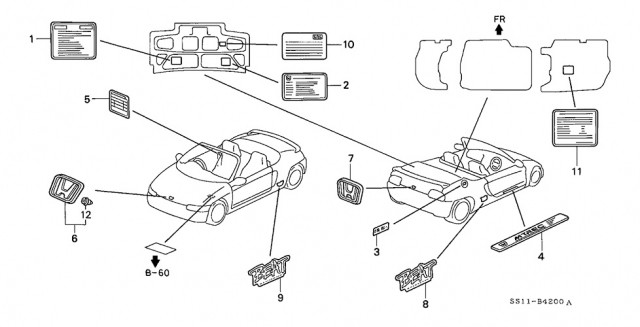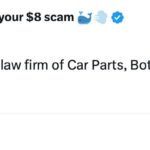The Honda Beat, a beloved mid-engined kei-class roadster, has captured the hearts of car enthusiasts worldwide. For owners and admirers alike, the news of the Honda Beat Parts program has been a beacon of hope, ensuring the longevity of this iconic vehicle. Since its announcement in August 2017, this initiative has steadily expanded the catalog of available components, breathing new life into these classic machines. However, understanding the sheer effort involved in bringing these parts back into production reveals the truly remarkable nature of the Beat Parts program.
Image: Close-up of genuine Honda Beat parts emblems, showcasing the commitment to authenticity in the parts reproduction program.
A revealing interview by Japanese automotive journalists at Car Care Plus with six Honda employees at the heart of the Beat Parts project sheds light on the intricate processes and corporate dedication required to make this program a reality. Their insights unveil the meticulous planning and monumental effort needed to revive parts production for a car that has been out of production for over two decades.
One of the initial hurdles Honda faced was gauging the actual demand for Honda Beat Car Parts. Typically, a large automaker like Honda discontinues parts production approximately 15 years after a model ceases manufacturing. This decision is usually dictated by the dwindling demand at dealer parts counters.
Image: A dark green Honda Beat roadster, highlighting the enduring popularity and demand for these kei cars, which prompted the parts reproduction program.
The Honda Beat, produced from 1991 to 1996, was never a high-volume seller. However, remarkably, in 2015, Honda observed that around 30 percent of the original parts were still experiencing consistent sales. Further investigation revealed that of the 33,892 Beats initially sold, an impressive 19,759 were still registered and on the road. This remarkable 58.3 percent survival rate signaled to Honda that a dedicated parts program was essential. Without continued parts support, the number of roadworthy Beats would inevitably decline as sourcing replacement components became increasingly difficult.
It’s important to remember that Honda didn’t manufacture all 1,600 individual parts that comprise the Beat in-house. A significant portion of these components were sourced from a network of suppliers spread across Japan. To assess the feasibility of parts reproduction, Honda representatives embarked on a comprehensive tour, visiting 90 partner companies. Their mission was to evaluate the availability of original molds, production lines, and manufacturing jigs. Alongside supplier visits, Honda also consulted repair shops, dealerships, and crucially, Honda Beat owners themselves. These consultations were vital in determining which Honda Beat car parts should be prioritized for reproduction based on real-world needs and demand.
Image: Top-down view of a Honda Beat, illustrating the car’s compact dimensions and sporty design, emphasizing the need for specialized and model-specific car parts.
From this extensive research, Honda selected an initial offering of 100 Honda Beat parts for the program. This initial batch included critical and sought-after items. Major components like the heater blower assembly and taillights were included, alongside distinctive elements like the “takoyaki” steel wheels. The program also addressed seemingly minor but essential parts, such as the outer tongue of the right-side (driver’s side in Japan) seat belt. In Japan, the strict Shaken roadworthiness inspection means that even seemingly small component failures, like license plate light lenses, can render a car unroadworthy. Therefore, the inclusion of even minor Honda Beat car parts in the reproduction program is crucial for keeping these cars legally on the road.
“It all rests with the suppliers,” explained Shinji Aso, manager of the Parts Sales Planning Division. Aso, who previously managed Beat parts delivery to the Suzuka factory production line during the car’s original production run, understands the delicate relationship with suppliers. Requesting the reproduction of a part, especially for a low-volume classic car, can be a significant undertaking for a supplier. Honda is acutely aware of this and continuously strives to minimize the burden placed on these crucial partners, recognizing that their cooperation is paramount to the program’s success.
Image: A cutaway illustration of the Honda Beat, showcasing the mid-engine layout and complex engineering, highlighting the intricate nature of its component parts.
The complexity of even a single Honda Beat car part is often underestimated. As Yuichi Kanda, head of the Parts Procurement Assurance Section, pointed out, a seemingly simple damper can be comprised of as many as 12 individual pieces. If just one of these sub-components is unavailable, the entire part cannot be assembled. Kanda recounted that bringing the damper back into production alone took an arduous year and a half, requiring the close collaboration of multiple partner companies.
Honda’s commitment to this project is exemplified by their emphasis on face-to-face engagement with suppliers. This hands-on approach necessitates countless hours spent physically visiting each partner company, building relationships, and ensuring clear communication. Kanda shared an anecdote illustrating this dedication. On the morning of a crucial meeting with a supplier regarding a small wiring harness section for Honda Beat car parts, he encountered a Beat at a local convenience store. He took this chance encounter as a positive sign. Indeed, the meeting proved fruitful, and Honda successfully added the wiring harness section to the Beat Parts catalog in June 2018.
Image: Rear view of a Honda Beat, emphasizing the car’s sporty styling and the availability of reproduction parts to maintain its original aesthetics and functionality.
To date, the Honda Beat Parts program has successfully reintroduced 92 reproduction parts, with more in development. Future additions are anticipated, including tie rod ends, a fuel return line, and a purge regulator return hose. However, the availability of these Honda Beat car parts may not be indefinite. For instance, the supplier for the brake caliper has committed to production only until 2023, highlighting the ongoing challenges of long-term parts availability.
Ultimately, the Honda Beat Parts program underscores the immense challenge of coordinating diverse suppliers and their manufacturing capabilities. It’s often a more complex undertaking than the physical act of manufacturing the parts themselves. It’s not simply about recreating molds or developing new technologies, as seen in Nissan’s innovative dieless body panel forming for Skyline GT-R parts. The program’s success hinges on countless unseen hours of meticulous planning, relationship building, and strategic decision-making behind the scenes. This initiative truly deepens our appreciation for the dedication of manufacturers like Honda, Mazda, Nissan, and Toyota, who are committed to supporting enthusiasts by making crucial parts available for their cherished classic vehicles.

